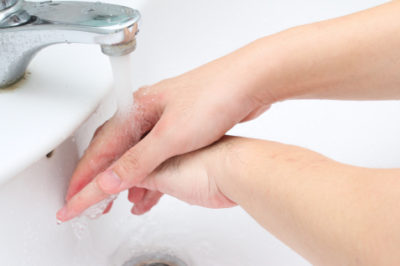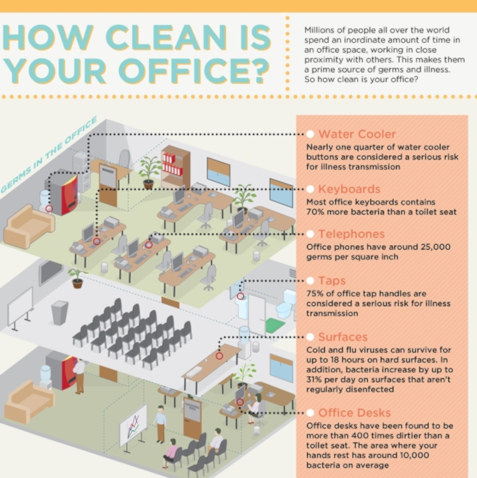Sloppy Hand Hygiene in Offices: What a Mistake

Editor’s note: this article was originally published in 2019, and has been amended in August 2020 with more accurate and updated information.
We spend most of our time in the office, but have you ever wondered how clean it is? With bacteria brought in from homes, public transport and the general public environment, keeping your office clean is an important aspect to maintain an acceptable standard of office health and wellbeing.
Did you know that your average desk at work is 100x less hygienic than your kitchen table? Feeling like drinking some water? You’ll find 228,854 million bacteria lurking on your kitchen tap handle.
It’s important to take care and prioritise your staff’s health and wellbeing and promote a healthy workplace, which could include purchasing equipment designed to improve the health of your staff. But have you ever thought about also educating your staff on proper hand hygiene?
The simple act of washing hands can protect your staff from many illnesses. According to the Centres for Disease Control and Prevention, 80% of infectious diseases are transmitted by touch.
How Often Do Australian Office Workers Wash Their Hands?
You may think hand washing is the most common office etiquette rule your colleagues are already following, but in reality, this is far from the truth.
The Australian Food Safety Information Council’s (FSIC) study showed we’re back to ground zero when it comes to hand washing. According to the study 3 in 10 men you shake hands with fail to wash their hands after using the toilet.
But this brings us to another question – do we know and understand how to wash our hands long enough to kill the germs on them? Unfortunately according to the Michigan State University researchers, only 5% of people washed their hands with enough precision to correctly remove and kill the germs on their hands. Thankfully, there are ways to get round poor hand hygiene performance in your office.

Image from www.ccohs.ca
What Are the Risks Associated With Poor Hand Hygiene?
Dangers from not washing hands do not end at merely a few coughs and a sneeze here and there. The immune system in adult humans is typically strong enough to fight off the infections caused by office germs.
But it is when the germs multiply and spread around your office that they can wreak havoc for your staff and your business. And it doesn’t end there as well.
Skipping hand washing can hurt your business in more ways than one. So, let’s have an honest look at what may be in store for you when you neglect it.
Your Office Becomes a Hub of Germs
Next thing, you turn up at the office, go to the bathroom and forget to wash the germs that commuted with you off your hands. What happens next is they reach your colleagues almost as quick as a morning briefing reaches their inbox. Whenever your colleague coughs or sneezes the droplets are expelled into the air you breathe. But these tiny particles also turn your office surfaces into a germy minefield.
Touch these surfaces and then touch your mouth, nose or food and you have a good chance of picking up the infection.
This holds true all the more so for those working in open-plan offices. It is here that germs migrate faster since many people circulate in the same space.
Open-plan spaces have a 62% higher incidence of staff absence compared to those in private or shared cellular offices. An average office desk harbours roughly 10 million germs. 400 times more than found on a standard toilet seat.
Germs are lurking everywhere. But what are the most notorious hotspots? Researchers swabbed 4800 surfaces in office buildings and came up with “officially dirty” badge holders.
These are:
- breakroom sink tap handles (75% incidence of being dirty)
- microwave door handles (48% incidence of being dirty)
- computer keyboards (27% incidence of being dirty)
- refrigerator door handles (26% incidence of being dirty)

Image from Office Clean
Your Employees Are More Likely to Get Sick
You can skip cleaning your hands but it’s hardly worth the hassle. All it takes is a good hand rub at the sink or a mere 30 seconds of rubbing with a hand sanitiser.
There are different pathways through which your office workers can get infected:
- Airborne infections. They are transmitted through the air after an infected person has coughed, sneezed or spoke.
- Contact infections. They involve having direct physical contact with an infected person. Examples of transmission include handshaking or coming into contact with an infected person’s blood or bodily fluids.
- Indirect contact infections. The infection spreads by touching an object or a surface that has been contaminated by an infected person.
So what are the most common diseases caused by unclean hands in the office?
Respiratory Illnesses
Respiratory illnesses spread rapidly in office environments. Talking about flu, the first line of defence would be to send an infected worker home.
Why? These highly infectious diseases spread by sneeze or cough droplets that keep lingering in the air.
According to an MIT study the rush of air after coughing or sneezing can travel as far as 60 metres into the room. Chances are slim the infected employee won’t take other coworkers down with them.
Most common respiratory illnesses include:
- Rhinoviruses like common cold and influenza.
- COVID-19
- Group A and B streptococcal infections
- Chickenpox
- Meningitis
Hopefully, this video featuring an office flu experiment will be an eye-opener for you.
Wonder how to curb the spreading of airborne infections? The truth is you can get big results from small efforts. Instruct your office staff to:
- Use good sneezing and coughing etiquette by sneezing into their handkerchief or their elbow
- Inspire them to practice good hand hygiene by washing hands with soap and water
- Make hand hygiene a matter of no hassle at all. Fit your common office areas with automatic hand sanitiser dispensers
These preventive measures can help you get through even the nastiest flu season.
The Institute for Healthcare Improvement (IHI) suggests alcohol-based hand rubs as the most effective and practical solution for hand hygiene in most settings. As reported by IHI, the whyfors are the following. They are:
- Easy to use
- Good at rapidly decreasing bacteria counts on hands
- Reported as a cleaning method that increases hand hygiene adherence
- Said to reduce illness-related absences
Noroviruses
Your office desks, stationary and coffee pot can look as neat as a pin. But as you know, things aren’t always as they seem.
This may sound gross. But objects you keep handling on a daily basis may be covered with faecal matter.
These invisible minute particles you can pick up anywhere in the office contain Salmonella, E. coli and norovirus contaminants. The three pathogens share similar symptoms, which are:
- nausea,
- vomiting,
- diarrhoea and
- stomach cramps.
The most typical ways noroviruses are transmitted throughout the office? Let’s have a quick look. They’re most typically spread:
- In enclosed areas populated by large groups of people. For instance, cruise ships, military barracks and open-space offices.
- When a person doesn’t wash their hands after using the washroom. Then goes about their business contaminating other office surfaces. Pretty much anything you touch in the washroom can contaminate your hands. Simply flushing the toilet launches millions of bacteria all around the cubicle space.
- When office workers fail to practice hand washing before eating or handling food.
- By touching smartphones after we’ve taken them with us on the trip to the loo. The pathogens that remain on the phone surface will recontaminate hands each time we reach of the phone.
Hepatitis A
Hepatitis A is a viral liver disease that can take milder or more severe forms. The viral infection is linked to poor sanitation and hand hygiene. And is listed as one of the most common causes of foodborne infection.
It’s characteristic symptoms are:
- lack of appetite,
- abdominal pain,
- jaundice,
- fever and fatigue.
When it comes to Hepatitis A, beware of the office pantry. Below are the ways it’s usually passed on in office environments. It’s spread by:
- The faecal-oral route. When a person ingests food that has traces of a contaminated person’ faeces.
- Close personal contact. The virus can be transmitted by touching the infected person or having close physical contact.
Your Business Finances End Up a Mess
Still not quite sure about what this has got to do with you in particular? Join the dots. Hand hygiene blunders are one of the top causes of office sick days. This transposes to a yearly absenteeism cost of $44 billion to the Australian economy.
It can be completely off your radar. But the importance of hand washing is huge with regards to your finances too.
Step Up and Protect Your Workplace
Sloppy hand hygiene at your office requires action on your part. Basically, it comes down to the well-familiar fight-or-flight response. And it looks like this. Do something or face consequences of poor hand hygiene.
Just think about how much you’ll be able to save on fewer sick leave payouts.
Switch to a rental hygiene program. Fresh & Clean can help you raise the bar with your office hand hygiene. And keep it that way long term.
Our automatic hand sanitisers can easily find their way to your workstation areas, break rooms and office gardens.
All for a low fixed monthly fee. No hidden costs and no hassle at all. At least not on your part.
Give us a call now and we’ll tailor an individual hand care program that suits your workplace
